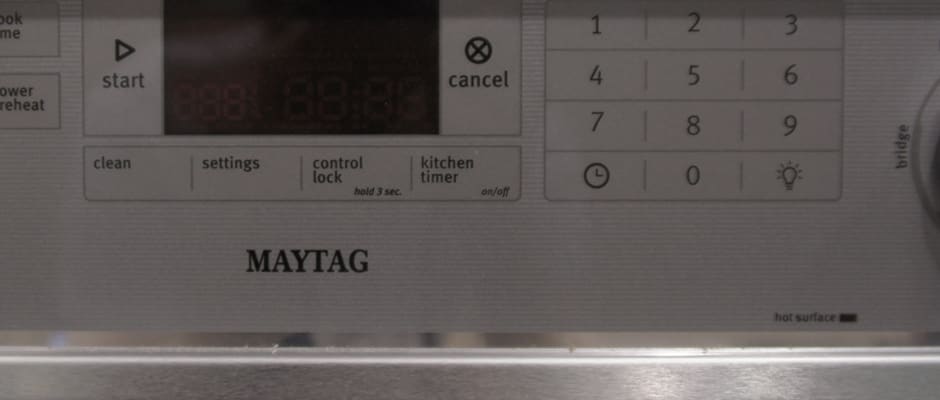Pros
Cons
Introduction
In our tests, the {{product.model}}'s rangetop performed very well in boiling, simmering, and searing. We found a flawed and complex character in the oven, finding good in the convection setting, and bad in the conventional setting. With a solid broiler and water-based cleaning system, this oven could be fantastic for your kitchen—especially if you've made the jump to convection cooking.
Design Overview
{{section_header}}{{section.name}}{{/section_header}}
The {{product.name}} is a 30" freestanding range with a single oven and stainless trim. Its control panel and design are familiar to anyone who has seen a Whirlpool-made range in the past few years. Stainless trim and a stainless door panel blend with black porcelain enamel. There's a grainy and substantial handle, which is quickly becoming part of Maytag's design language.
What differentiates it from other, similar Whirlpool-made ranges is AquaLift technology, which uses water for a gentler self cleaning cycle. More on that later
Unfortunately, the {{product.name}} also features controls on its back panel. That means users will have to brave fiery cauldrons just to keep soup from boiling over.
Front
{{section_header}}{{section.name}}{{/section_header}}
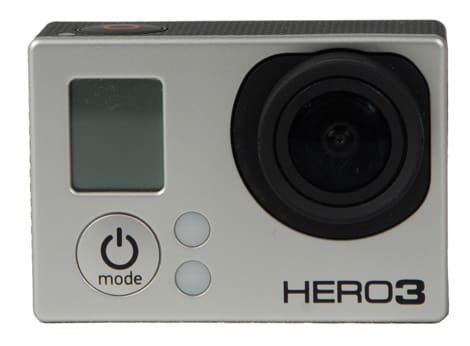
Range-top
{{section_header}}{{section.name}}{{/section_header}}
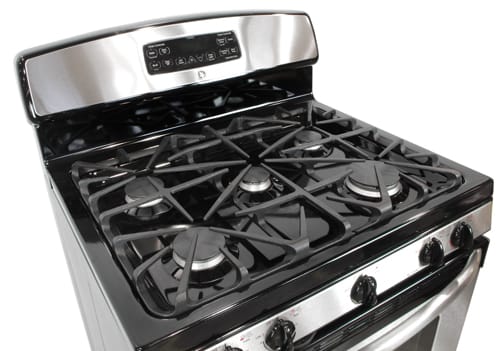
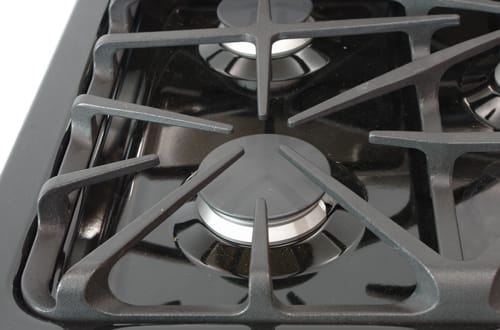
Upper Oven
{{section_header}}{{section.name}}{{/section_header}}
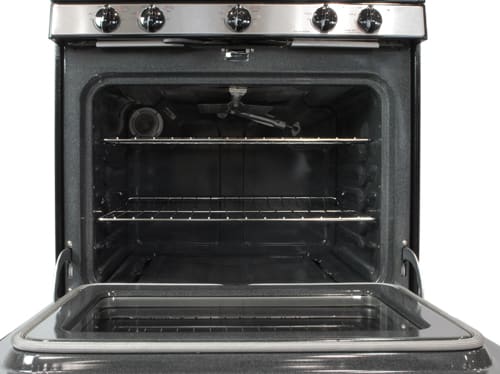
Broiler
{{section_header}}{{section.name}}{{/section_header}}
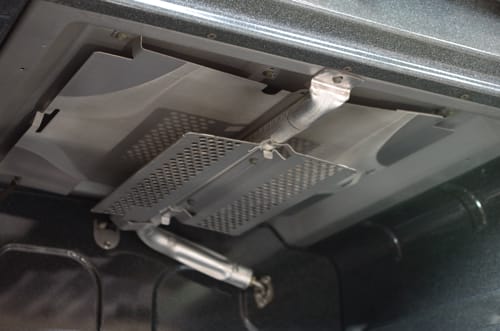
Warming Drawer
{{section_header}}{{section.name}}{{/section_header}}
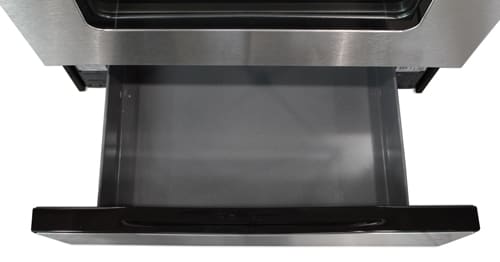
Cooking Performance
We found some impressive aspects of the {{product.name}}'s rangetop. The wide temperature range of the elements—hot enough to sear but gentle enough to simmer—as well as the ability of every element to boil reasonably quickly reminded us again that electric ranges have redeemable qualities. The cavity below, however, did not particularly impress, with its massive overshooting of the target temperature after the preheat, and long periods of variance away from the target before the overcorrection. Despite the shortcomings of the conventional oven, the convection mode did gain our approval.
{{photo_gallery "Primary Oven Keep-Warm Ramp-up", "Primary Oven 350F Ramp-up", "Primary Oven Max Ramp-up", "Secondary Oven Convection Ramp-up", "Oven Temperature Variance", "Range-top Water Boil", "Range-top Temperature Range"}}
Range Performance Overall
{{section_header}}{{section.name}}{{/section_header}}
{{product.brand.name}} laid out the rangetop elements in an interesting way. The main twelve-inch power burner occupies the front left position, and two smaller burners flank its rear and function as ears for the Mickey Mouse face of the main burner. The right ear (or center burner) is a warming burner. To the right lie two eight-inch elements connected by a bridge element. All the standard elements performed well, boiling water quickly and showing a good temperature range.


Water Boiling
{{section_header}}{{section.name}}{{/section_header}}
The water boiling results differed on this Maytag compared to many of the other ranges we've seen as every element gave us a steamy performance. While the quickest boiling element wasn't the fastest we've seen, it did boil six cups of water in seven and a half minutes. To this range's credit, the other three boiled in ten, eleven, and sixteen minutes. Very few rangetops have so many capable burners, and the average boiling time for all of these proved to be phenomenal. Even the simmer element—not meant for boiling a pot of water—performed well. Unfortunately, depending on cooking habits a stellar average boiling time may not be as useful as one express boiler, as users are unlikely to be boiling four pots of water at once.
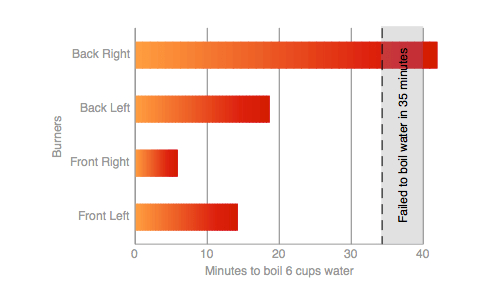
Don't try to boil with the back right simmer burner.
Low Temperature Cooking
{{section_header}}{{section.name}}{{/section_header}}
The {{product.name}}'s simmering situation proved satisfactory, with the rear left simmering burner capable of maintaining temperatures as low as 80°F, an incredible low we've not seen thus far. This is low enough to melt chocolate without a double boiler, and again proves that electric stoves have advantages over gas stoves—though many people still prefer the instantaneous temperature control and visual feedback of the blue flame. The rest of the burners did moderately well on the simmer, all achieving temperatures of 132°F or 133°F.
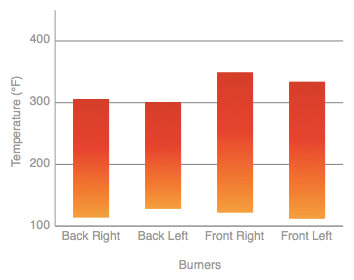
Maximum and minimum heat settings for each burner: The hottest burner reaches about 400F.
High Temperature Cooking
{{section_header}}{{section.name}}{{/section_header}}
We found very satisfactory results from this rangetop set on high. The temperatures of all the burners were high enough to sear meat properly, all attaining temperatures over 650°F. The front right and left rear burners got even a bit too hot, and should be used under supervision, as they got stoveware over 700°F.
Overall Oven Performance
{{section_header}}{{section.name}}{{/section_header}}
As we often see, the conventional setting is markedly inferior to the convection one. With each preheat—getting to 350°F took just under ten minutes—the oven got way too hot, reaching 400°F before cooling off. Upon cooling off, the temperature would drop far below 350°F, making the average 350°F but with a very shoddy standard deviation from that mean. There is a "Power Preheat" selection that activates the top broil element enabling a slightly faster preheat--a manufacturer stated eight minutes.
{{product.manufacturer_specs['Primary Oven Photo']}}{{photo_gallery "Primary Oven 350F Ramp-up", "Primary Oven Keep-Warm Ramp-up", "Primary Oven Max Ramp-up"}}
Target Temperature Accuracy
{{section_header}}{{section.name}}{{/section_header}}
The oven temperature range isn't quite what we normally see, as the maximum setting of 500°F is below the industry standard of 550°F. While most people don’t ever need to cook at 550°F and it’s probably safer not to have the option, some might like to have the option. On the lower bound of the temperature range, the keep-warm setting was a bit too warm, running a fever well into the 200s, straying from the preferred keep-warm temperature of 170°F. Sure, you can turn on the keep-warm setting and just turn it off after a few minutes, but it would have been nice to have a setting that keeps warm properly.
Temperature Fluctuation
{{section_header}}{{section.name}}{{/section_header}}
The {{product.name}} temperature consistency showed a classic trope from today's ovens and youth: fine modern abilities, but none for the conventional activities: dancing, singing, playing sports, or baking. This Maytag, which performed well in the convection mode, was unable to properly regulate its own temperature as a conventional oven, tradition be gone. Fortunately the benefits of convection cooking make it an attractive solution to exclusively use the convection oven, but who likes to have the decision made for them?
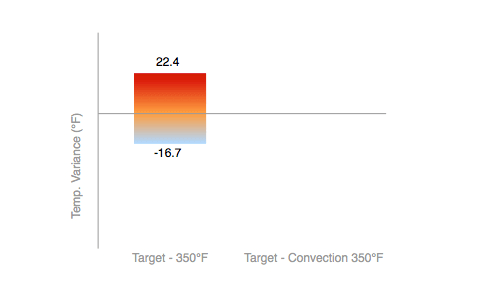
Oven "Margin of Error" in Temperature Variance: The oven is consistent at cool and mid-level temperatures, but inconsistent when operating at its warmest.
Broiler Performance
{{section_header}}{{section.name}}{{/section_header}}
The broiler, located on the roof of the oven cavity, heated up to 605°F in just seven minutes, although one doesn't necessarily have to preheat it fully before cooking begins, just for the five minutes recommended by the manual. Additionally, the door is to be kept open six inches whilst broiling, as per the manual. Here, the food's aroma is allowed to escape, an added benefit of this broiler.

Broiler Features
{{section_header}}{{section.name}}{{/section_header}}
While most broilers have just one or two settings ("on," or "HI" and "LO" if you're lucky), this broiler has an additional medium setting of 450°F, between the high and low of 500°F and 400°F respectively. While it might not be particularly useful, as you can't really control temperature too well on a charcoal grill, it's an option, which is always good to have.
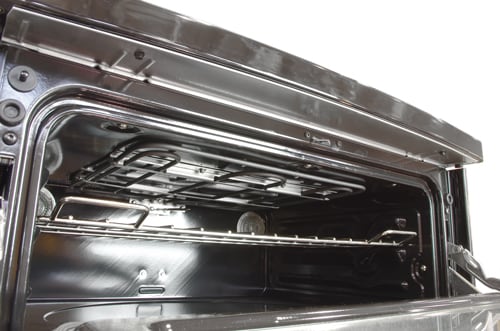
Overall Efficiency
{{section_header}}{{section.name}}{{/section_header}}
The range and oven both used a reasonable amount of electricity. Comparing the performance to the power draw yielded excellent results.
Range Efficiency
{{section_header}}{{section.name}}{{/section_header}}
The rangetop's performance was excellent when compared to its energy usage. It drew a combined total of 8754 watts, which isn't that much to spend for the good performance we found. Clearly, the energy is being put to use.
Oven Efficiency
{{section_header}}{{section.name}}{{/section_header}}
The main oven element drew 3604 watts, the broiling element 3572 watts, and the convection element 3505 watts. During the "Power Preheat," the oven uses the main heating element as well as the convection element, drawing the combined 7109 watts.
Features
{{section_header}}{{section.name}}{{/section_header}}
The unique way that {{product.brand.name}} set up their {{product.model}} rangetop might appeal to many, especially considering its solid performance. It does live up to its name of "Power Center." Headlining the rangetop is a triple element burner capable of twelve-, nine-, and six-inch diameters, accommodating a variety of stoveware. A bridge element accommodates even more stoveware—griddle anyone?—by linking the two eight inch elements on the right. A dedicated simmering element sits in the rear left position, but it also packs some boiling power. In the rangetop's center, a keep-warm burner is at users disposal to serve as the purgatory between range and table. Users may also appreciate the Mickey Mouse design the three elements make on the rangetop.

The oven has many features, although we have our doubts on their usefulness given the oven's performance. Inside the oven, the 6.2 cubic foot oven is divided by three racks, one of which is a recessed "Max" rack to accommodate large items.
In an attempt to mitigate the annoyance of preheating, Maytag added a "Power Preaheat" feature, that turns on the broiling element as well as the main oven element to heat the cavity up more quickly, in eight minutes. That's not bad, but we've seen ovens without any special feature get to 350°F more quickly.
One feature we did like quite a lot was the "EvenAir True Convection," in which a heated fan circulates air around the oven to attain even cooking temperatures throughout the oven and providing better heat transfer with the food. This is especially useful on this oven—it's the default setting—due to the incompetence of the conventional oven mode. Curiously, the oven's incompetence was even further compounded by saying their oven had a "Precision Cooking System," with "PrecisePreheat," "PreciseBake," and "PreciseBroil." Perhaps they've mistaken "precise" for "imprecise."
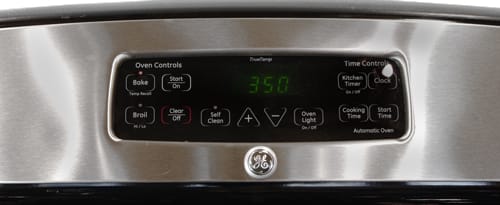
The timer is easy to set. Just press the timer button, key in a number and start the countdown. There's also a time bake and delay start option.
{{product.manufacturer_specs['Timer Photo']}}
Controls
{{section_header}}{{section.name}}{{/section_header}}
We'll never understand why some ranges have their controls on the back panel. If child safety is an issue, put a control lock on the back panel. Otherwise, it means that the user risks a steam burn every time he or she changes the temperature on a pot or pan.
Otherwise, the knobs themselves feel substantial and give about as much control as is possible for an electric range. One knob does double duty, turning on the bridge burner for cooking large items that span multiple burners. The center-mounted warmer only has an on/off switch.
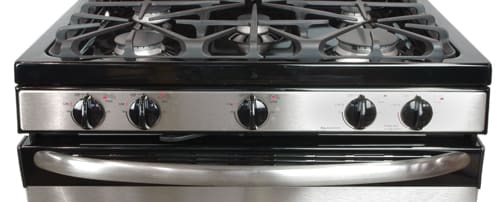
Oven controls are also on the back panel, and make use of a flat touchpad. We like to see that there's a single "cancel" button that will undo any errant keystroke. It's no help if you've just burned a roast, unfortunately.
Press either the bake or convection button to choose a cooking method, key in the exact temperature you want and then press start. It's quite easy, although all those buttons do look a bit antagonizing at first.

The broiler is a bit less intuitive. Press "Broil" and the {{product.name}}'s LED screen will ask you to choose a level. There are three levels on this range's broiler, and they're selected by pressing either the 1, 2 or 3 buttons on the numeric keypad, but that's not immediately apparent. For convection broiling, just key in a temperature.
{{product.manufacturer_specs['Broiler Controls Photo']}}
Cleaning
Conclusion
{{product.vanity}}
On sale for just under $1,000 (MSRP $1,094), the {{product.name}} offers a glut of features on this electric range, encased in stainless steel. After throwing it into our testing process, we developed a complex opinion about this oven, but all in all saw it in a favorable light.
To the rangetop's credit, solid boiling results from all the burners were married to similarly stellar temperature range, searing and simmering with the best of them. We thought the features were useful, and were pleased to see they didn't detract from the performance. We found we liked the interesting, unconventional setup of the "Power Center Electric Cooktop," especially since it didn't sacrifice performance. One thing we'd have liked to see was one element that could really boil quickly, although the average boiling time for all the elements was phenomenal.
Aside from all the oven's great features, its capacity, its racks, its cleaning system, it was clear that Maytag phoned in their conventional oven, as it produced horrible results for consistency and evenness of temperature. However, due to the default oven setting being convection, we can tell that Maytag expects the most use from that, which we appreciate, since the convection setting is quite satisfactory. Maytag subtly steers users toward convection—and away from convention—by setting it as the default. This is probably a good idea.
The bottom line for the {{product.name}}? This oven is a fantastic value and if you prefer convection cooking, take this home.
Meet the tester
Ethan writes reviews and articles about science for Reviewed.com, and edits the Science Blog. He's originally from Vermont and thinks the bicycle and guitar are examples of perfected technology. Prior to Reviewed.com, he studied furiously at Middlebury College.
Checking our work.
Our team is here to help you buy the best stuff and love what you own. Our writers, editors, and experts obsess over the products we cover to make sure you're confident and satisfied. Have a different opinion about something we recommend? Email us and we'll compare notes.
Shoot us an email